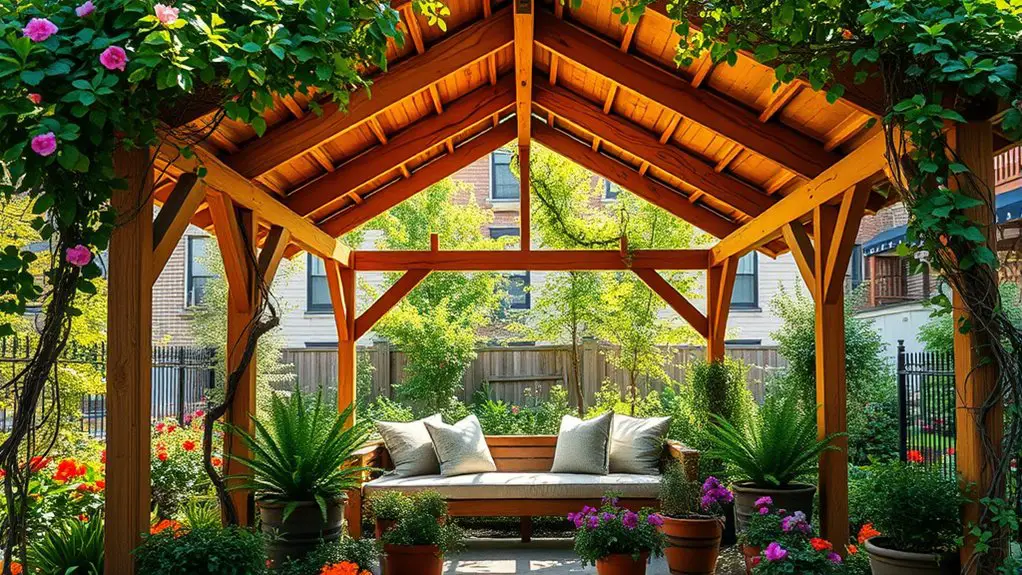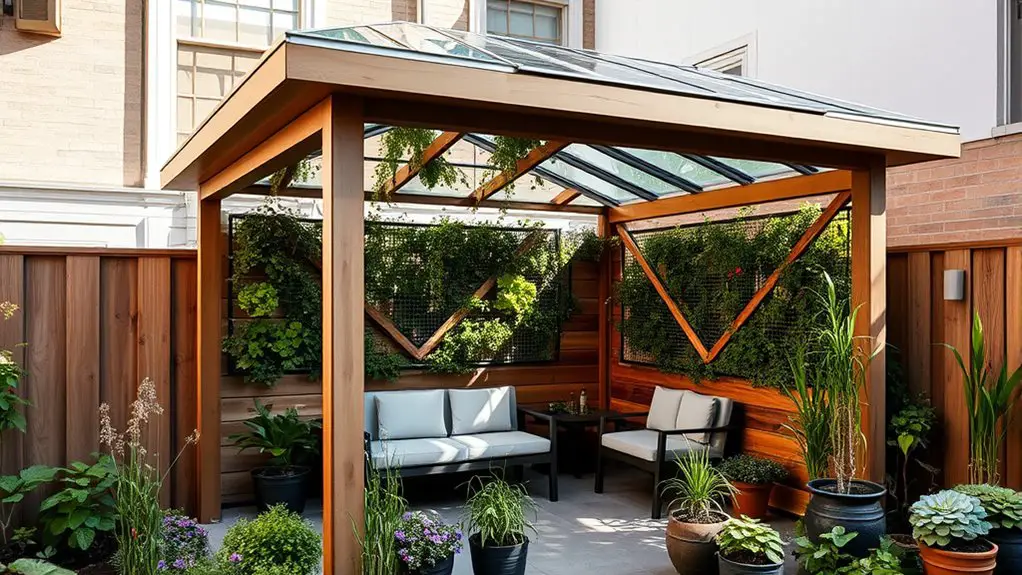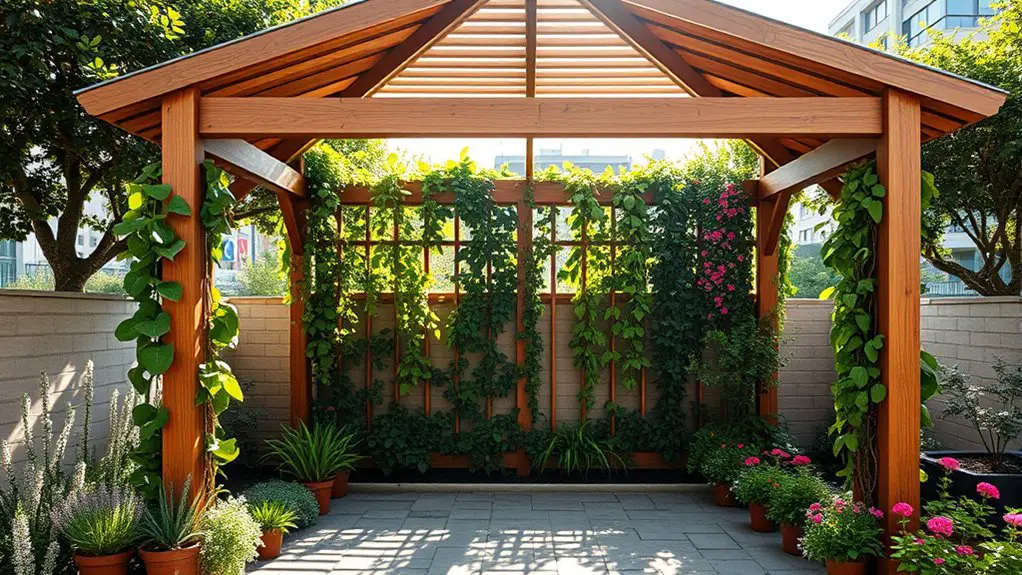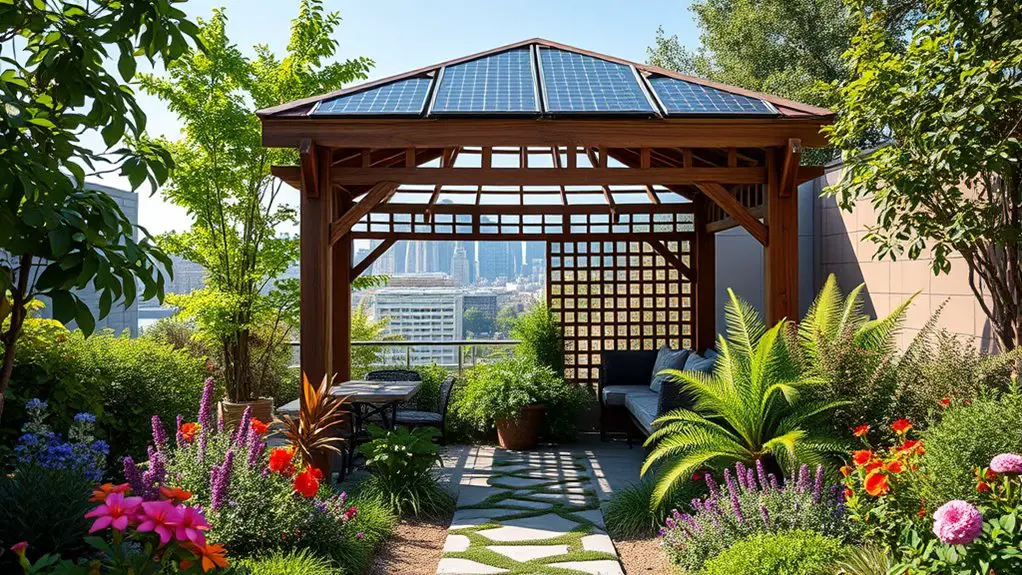Sustainable gazebo designs for small urban gardens can transform your outdoor space into an eco-friendly retreat. By choosing materials like reclaimed wood or bamboo, you enhance aesthetics while minimizing waste. Space-saving solutions, such as compact structures integrated with vertical gardens, add greenery without compromising space. Incorporating eco-friendly features like solar-powered lights and rainwater harvesting systems promotes sustainability. With careful planning, you can create a vibrant urban oasis that mirrors your personal style, and much more awaits you.
Benefits of Incorporating a Gazebo in Small Urban Gardens

When you incorporate a gazebo into a small urban garden, you not only enhance its aesthetic appeal but also create a multifunctional space that promotes sustainability. The gazebo serves as a focal point, drawing the eye and adding depth to your urban aesthetics. It provides shelter for outdoor gatherings, allowing you to enjoy nature without sacrificing comfort.
One of the key gazebo benefits is its potential for eco-friendly design; you can integrate planters or green roofs to bolster biodiversity and capture rainwater. This creates an inviting atmosphere while encouraging local wildlife. Additionally, the structure can act as a microclimate, offering shade and reducing heat in your garden, essential in urban environments. Furthermore, it increases property value by making your outdoor space more desirable and functional.
Choosing Sustainable Materials for Your Gazebo
When you’re selecting materials for your gazebo, consider eco-friendly wood options that not only enhance aesthetics but also promote sustainability. Recycled materials can offer unique textures and durability while minimizing your environmental footprint. By making informed choices, you’ll create a structure that’s both beautiful and responsible.
Eco-Friendly Wood Options
Choosing sustainable materials for your gazebo not only enhances its aesthetic appeal but also supports environmental stewardship. When selecting wood, consider these eco-friendly options:
- Bamboo alternatives: Fast-growing and highly renewable, bamboo is a durable choice.
- Reclaimed options: Utilize wood salvaged from old structures, reducing waste and giving your gazebo character.
- FSC-certified lumber: Verify your wood comes from responsibly managed forests, promoting sustainable forestry practices.
- Thermally modified wood: This process enhances durability without harmful chemicals, making it a safer choice.
- Locally sourced timber: Reduce your carbon footprint by choosing wood harvested nearby, supporting local economies.
Recycled Material Considerations
While many people focus on traditional materials for their gazebo, incorporating recycled materials can greatly enhance sustainability. By choosing reclaimed wood, you can not only reduce waste but also add character and history to your structure. This wood, salvaged from old buildings or furniture, brings a unique aesthetic, allowing your gazebo to stand out. Additionally, consider using recycled plastics for non-structural elements like furniture or decorative features. These materials are durable, low-maintenance, and resistant to the elements, ensuring your gazebo’s longevity. Plus, they come in a variety of colors and designs, giving you the freedom to express your style. By thoughtfully selecting these materials, you’ll create a stunning, eco-friendly retreat in your urban garden.
Space-Saving Gazebo Designs for Limited Areas

When space is tight, you can still create an inviting outdoor haven with innovative gazebo designs. Consider multi-functional options that serve various purposes, or integrate vertical gardens to maximize your greenery without sacrificing floor space. Compact and foldable designs also offer flexibility, ensuring you make the most of every inch in your limited area. Additionally, enclosed gazebos provide protection from the elements while enhancing your outdoor living experience.
Multi-Functional Gazebo Options
If you’re looking to enhance your outdoor space without sacrificing much room, multi-functional gazebos offer innovative solutions that blend utility and sustainability. These designs maximize functionality while seamlessly integrating with your garden. Here are some key features to examine:
- Convertible structures: Easily shift between a gazebo and a pergola, adapting to various needs.
- Integrated storage: Keep your outdoor furniture organized and protected.
- Built-in seating: Maximize space with benches that double as storage.
- Eco-friendly materials: Choose sustainable wood or recycled metal for a greener footprint.
- Lighting options: Incorporate solar-powered lights to illuminate your evenings.
With thoughtful planning, these space-saving designs can create a vibrant outdoor haven, offering both comfort and freedom in your urban garden.
Vertical Garden Integration
Incorporating a vertical garden within your gazebo design can transform limited outdoor spaces into lush, green retreats. By maximizing vertical space, you can enjoy the numerous vertical garden benefits, such as improved air quality and enhanced aesthetics. Choose plants that thrive in your local climate, and you’ll create a vibrant, living wall that serves both beauty and function.
When it comes to vertical garden maintenance, select low-maintenance options like succulents or herbs that require minimal care. Using a drip irrigation system can also simplify watering, ensuring your garden flourishes without much effort. This innovative approach not only saves ground space but also adds a unique, eco-friendly touch to your gazebo, inviting you to bask in your personal oasis.
Compact, Foldable Designs
For those with limited outdoor space, compact and foldable gazebo designs offer a practical solution that maximizes functionality without compromising style. These innovative structures allow you to enjoy your garden while being mindful of sustainability.
Consider these benefits of compact designs and foldable solutions:
- Space Efficiency: Easily stow away when not in use, freeing up your garden area.
- Lightweight Materials: Often made from recycled or eco-friendly materials, promoting sustainability.
- Versatile Use: Perfect for gatherings, yoga sessions, or quiet retreats.
- Quick Assembly: Designed for easy setup and takedown, saving you time.
- Customizable Options: Available in various styles and colors to suit your aesthetic.
Embrace the freedom of compact living while enhancing your urban garden experience!
Integrating Greenery: Combining Gazebos With Vertical Gardens

While you might envision a gazebo as a standalone structure, combining it with a vertical garden can transform your outdoor space into a lush oasis. Integrating vertical garden systems not only maximizes limited space but also enhances the aesthetic appeal of your gazebo. Imagine climbing vines or vibrant flowers cascading down the sides, creating a serene environment for relaxation or gatherings.
By strategically placing planters around your gazebo, you encourage urban greenery integration, promoting biodiversity and improving air quality in your small garden. Choose plants that thrive in your climate and require minimal maintenance, ensuring a sustainable approach. Additionally, selecting climbing plants that provide natural shade can enhance the comfort of your gazebo space.
Consider incorporating trellises or wall-mounted planters that complement your gazebo’s design, allowing you to express your creativity while cultivating a vibrant ecosystem. This harmonious blend of structure and greenery invites nature into your urban life, giving you the freedom to enjoy a peaceful retreat amidst the hustle and bustle.
Eco-Friendly Features to Consider in Your Gazebo Design
When designing your gazebo, consider integrating eco-friendly features that not only enhance its functionality but also align with sustainable practices. Embracing these elements can create a space that’s both beautiful and environmentally conscious.
Integrating eco-friendly features into your gazebo design can create a stunning and sustainable outdoor space.
- Solar panel integration: Harness renewable energy to power lights or small appliances.
- Rainwater harvesting: Collect rainwater for irrigation, reducing waste and conserving resources.
- Recycled materials: Use reclaimed wood or metal for construction, minimizing environmental impact.
- Natural ventilation: Design for airflow to reduce the need for artificial cooling.
- Native landscaping: Surround your gazebo with local plants that require less water and support biodiversity. Additionally, consider using waterproofing techniques to ensure that your gazebo remains functional and durable in various weather conditions.
DIY Sustainable Gazebo Projects for Urban Gardeners
Integrating eco-friendly features into your gazebo not only enhances its aesthetic appeal but also provides a perfect opportunity for urban gardeners to create a sustainable retreat. Start by selecting DIY materials like reclaimed wood or bamboo, which not only reduce waste but also align with urban aesthetics. You can design a compact gazebo that fits your small garden while incorporating green roofing—using plants to absorb rainwater and provide insulation.
Consider adding a rainwater collection system to your gazebo’s structure; it’s a smart way to water your plants sustainably. Solar-powered LED lights can illuminate your space, creating a cozy ambiance without straining your energy resources. Don’t forget to include vertical gardens or hanging planters to maximize your gardening potential. Regular cleaning and maintenance of your gazebo will ensure that it remains a vibrant and functional part of your urban oasis. This hands-on approach allows you to express creativity, contributing to a vibrant urban ecosystem while fostering a unique sanctuary that reflects your personal style.
Inspiring Examples of Sustainable Gazebos in Urban Settings
As urban spaces evolve, sustainable gazebos are emerging as innovative solutions that blend functionality with eco-conscious design. If you’re seeking urban gazebo inspiration, consider these standout examples that embody sustainability:
- Reclaimed Materials: Gazebos constructed from salvaged wood or recycled metals, minimizing waste and promoting a circular economy.
- Green Roof Systems: Structures topped with vegetation that enhance biodiversity and improve air quality while providing natural insulation.
- Solar-Powered Lighting: Incorporating solar panels to illuminate your gazebo, reducing reliance on grid electricity and lowering energy costs.
- Rainwater Harvesting: Designs that collect rainwater for irrigation, turning your gazebo into a self-sustaining oasis.
- Native Plant Integration: Surrounding the gazebo with native flora that requires less water and supports local wildlife.
These innovative designs not only enhance your garden but also reflect a commitment to sustainability and environmental stewardship.
Frequently Asked Questions
How Much Does a Sustainable Gazebo Typically Cost?
A sustainable gazebo typically costs between $2,000 and $10,000, depending on eco-friendly materials and design complexity. Budget considerations are essential, so weigh your options wisely to create a charming, environmentally conscious outdoor space.
Can I Get Permits for a Gazebo in My Urban Garden?
Imagine you’re building a cozy gazebo in your urban garden. To get permits, you’ll need to check local gazebo regulations and urban zoning laws, ensuring your peaceful retreat complies with city requirements and enhances your space.
What Maintenance Do Sustainable Gazebos Require?
Sustainable gazebos require regular upkeep like cleaning and inspections. With durable materials and eco-friendly finishes, you’ll guarantee longevity. Just check for wear and tear, and you’ll enjoy your space without constant worry.
Are There Specific Plants to Avoid Near a Gazebo?
Imagine a garden where invasive species choke the life out of your favorite blooms. You wouldn’t want that near your gazebo. Instead, choose compatible plants that’ll thrive together, creating a harmonious, vibrant sanctuary for relaxation.
How Can I Enhance Privacy in My Urban Gazebo?
To enhance privacy in your urban gazebo, consider fencing options like trellises or lattice. You can also add privacy screens made from natural materials, creating a serene space while maintaining an eco-friendly atmosphere that encourages relaxation.

